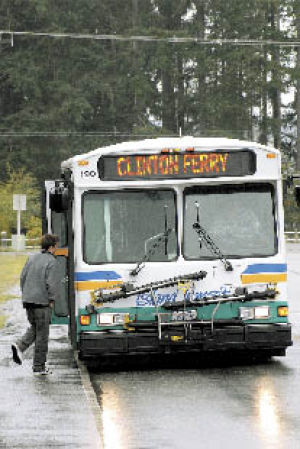The number of islanders hopping aboard buses has climbed to the highest level since Island Transit was founded 20 years ago as soaring gasoline costs push more commuters to use public transportation.
“Our ridership is definitely up,” said Martha Rose, executive director of Island Transit.
Gas prices are at a record high and so is Island Transit’s ridership.
Since February of 2007, the number of people catching the bus has increased 12.1 percent. In February, 93,273 people rode the bus — up from 83,193 last year at the same time, according to Island Transit.
Rose said ridership has especially increased on long-distance routes such as the Everett Connector and the Tri-County Connector.
Ridership began to surge when gasoline hit the $3 a gallon level in 2005 and has continued to rise steadily ever since as pump prices continue to climb.
Even when gasoline prices dipped last year and some people returned to driving, others appear to have switched to public transportation permanently, Rose said.
“What we have experienced is when gas prices spike, we gain riders,” Rose said.
“Every time prices go down, we lose some, but most stay,” she added.
One of these riders is Rick McIntyre, an engineer with Whidbey Telecom, who commutes from Oak Harbor to Bayview every day.
“I made the commitment to do it last fall,” McIntyre said.
“It was the cost of transportation. Gas has been too expensive for the last five years,” he added.
There have been small sacrifices, however.
Taking the bus extends his workday by 90 minutes, McIntyre said, and he had to give up going for a run in the morning to catch the bus in time.
“It was a lifestyle change,” he said.
But it’s worth it, he added. “It saves me $40 a week.”
The trend on leaving the car parked at home here is mirrored nationwide. Mass transit use increased by more than 2 percent in 2007 to the highest level in 50 years, with Americans taking more than 10 billion trips on public transportation while the number of vehicle miles traveled was flat in the first 10 months of the year, according to the American Public Transit Association.
Currently, more than 3,100 people use Island Transit buses each day on Whidbey and Camano islands. The bus is fare free, and gas prices on the South End are in the neighborhood of $3.59 a gallon.
The cheapest gas in Washington has been reported in Aberdeen at $3.25 a gallon. The Oak Harbor ARCO station offered gas at $3.29 last week.
The most expensive gas was in Winthrop, at $3.69 a gallon.
Rising fuel cost is also a problem for Island Transit.
Last February, a gallon of diesel cost the company $2.20. Now it’s $2,88 — a 31.3 percent increase.
With many analysts predicting $4 gasoline this summer, the appeal of mass transit is likely to become even greater.
Linda Irvine, who works as a conservation coordinator for the city of Langley, commutes before work from Langley to her gym in Freeland with Island Transit.
She said she observes an influx of new faces on the bus every time gas prices hit a new psychological milestone, such as the $3, then $3.50 mark. She has also met more people recently that take the bus for leisure time, traveling like her, Irvine said.
Her motivation was not the gas prices, but she is reaping the benefits.
“I started commuting by bus because I was concerned about climate change, but then I realized it had all these other side effects,” Irvine said.
“I’ve saved about $2 a day on gas,” she added.
The trend promises to continue and the reason is simple.
“Gas won’t be cheaper next week,” McIntyre said.
Michaela Marx Wheatley can be reached at 221-5300 or mmarx
wheatley@southwhidbeyrecord.com.


